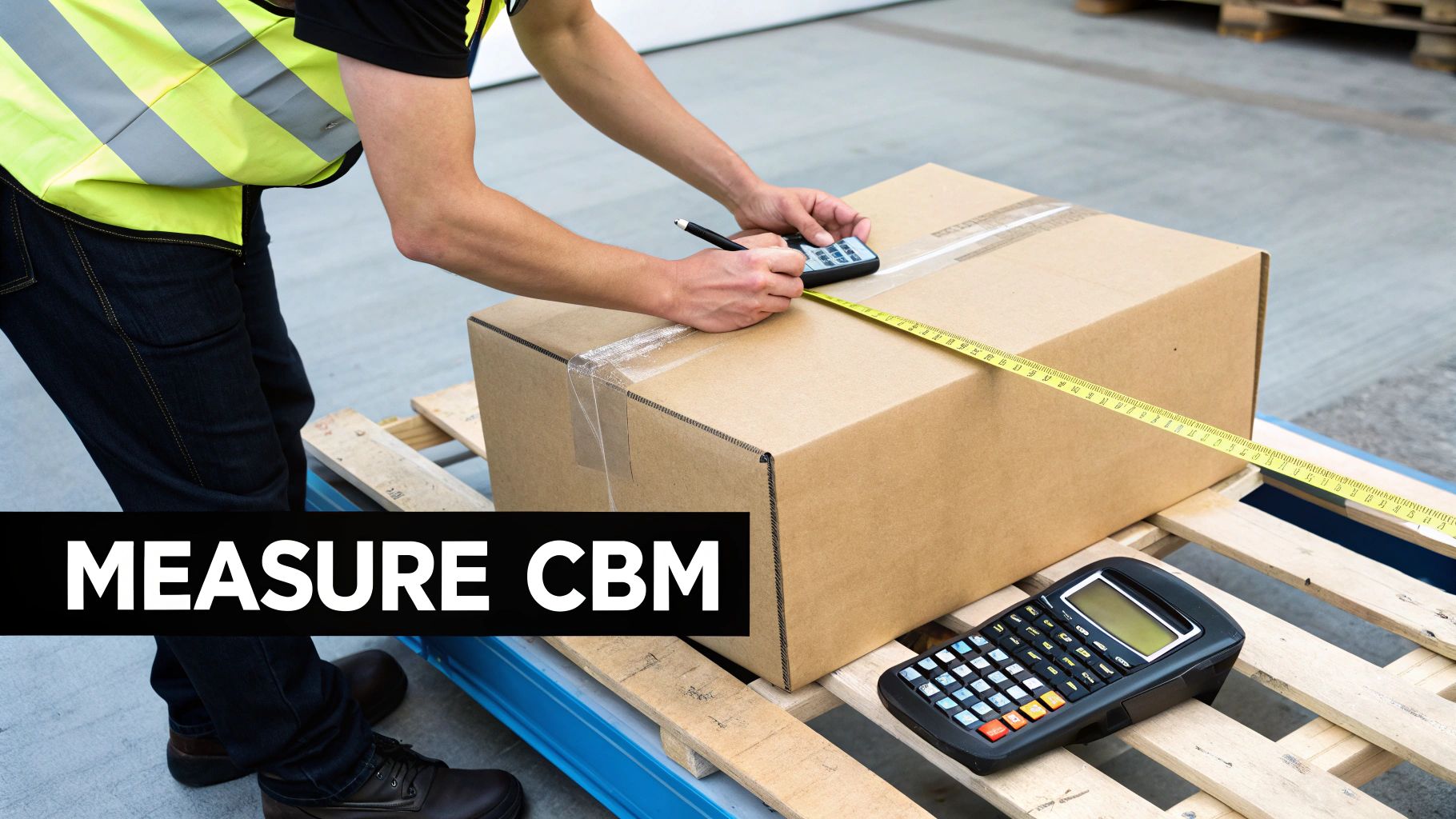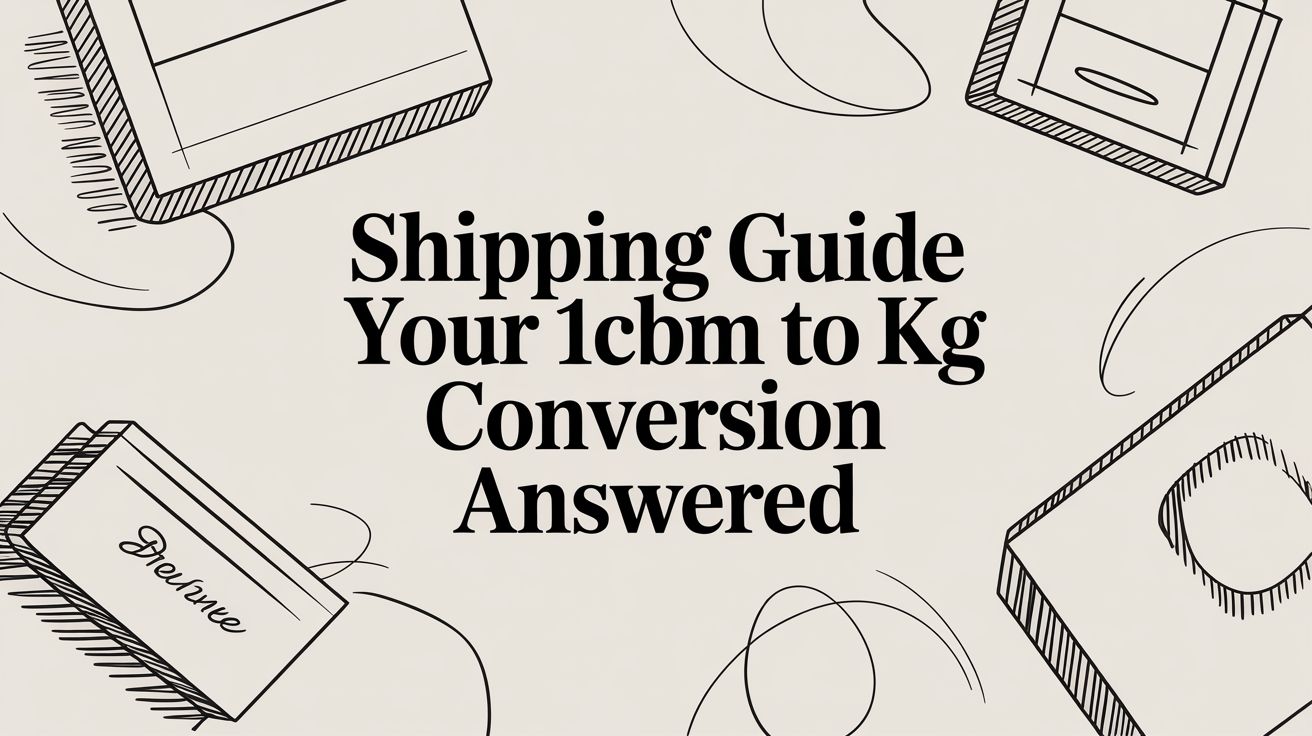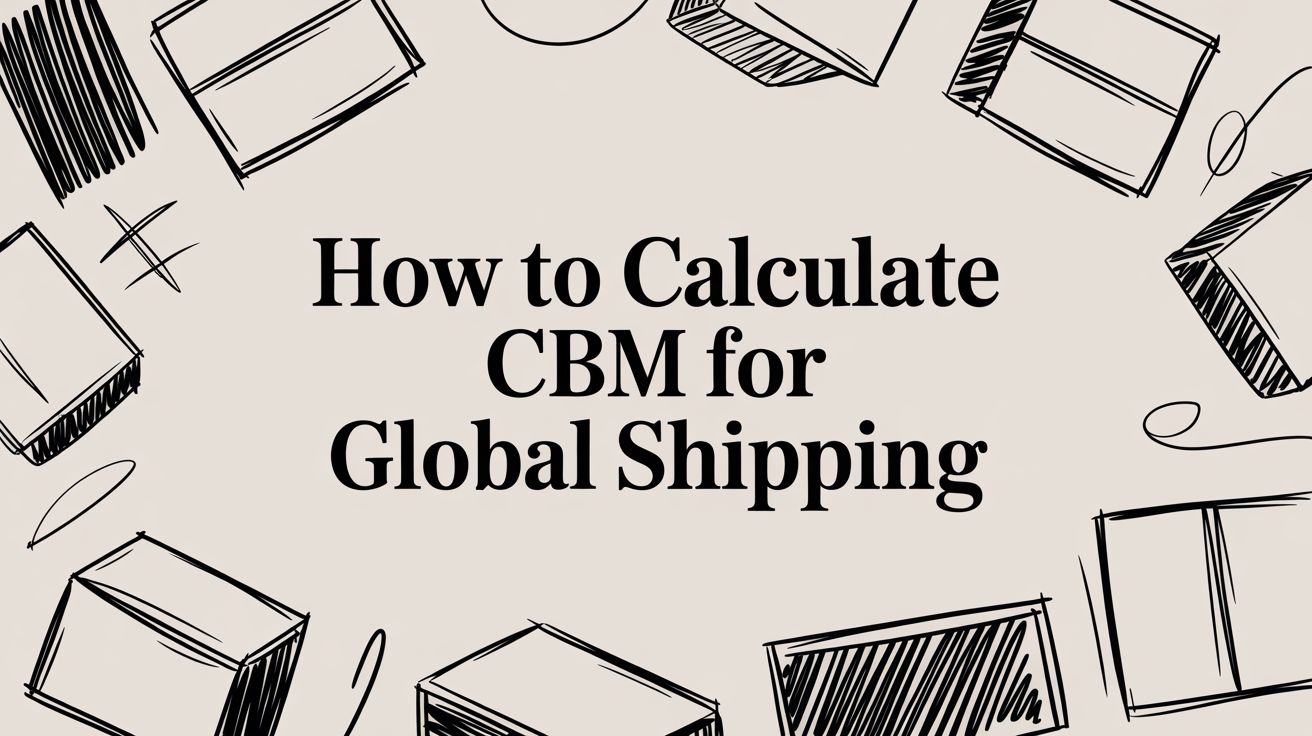How much does 1 CBM weigh in kg? That's the million-dollar question in shipping, and the honest answer is: it completely depends on what you're sending.
There’s no magic number for converting 1 CBM to kg. A cubic metre of fluffy cotton sweaters is going to weigh a whole lot less than a cubic metre of solid steel beams. The secret to bridging this gap lies in a single, crucial factor: your cargo's density.
Why Density Is the Key to Your Shipping Weight
When you're trying to figure out how much your shipment weighs based on its size, you're dealing with one of the most fundamental challenges in logistics. Freight carriers are always playing a game of Tetris with both space and weight.
Think about it: a cargo plane could fill up its entire hold with big, puffy duvets long before it hits its maximum weight limit. On the other hand, a small pallet of gold bars could make the plane too heavy to take off while leaving most of the space empty. This balancing act is precisely why density is the critical link between CBM and kg.

The Simple Formula That Connects Volume and Weight
The relationship between how much space your cargo takes up and how much it actually weighs comes down to a simple but powerful formula. If you're an importer, this is one to remember. It’s the bedrock for converting 1 CBM to kg for absolutely any type of product.
Kilograms = CBM × Density (in kg/CBM)
All this formula says is that to find the real, physical weight of one cubic metre of your goods, you just need to know how dense they are. So, if you're shipping a product with a density of 500 kg per cubic metre, then exactly 1 CBM of it will weigh 500 kg. Simple as that.
This isn't just a guideline; it's a universal principle in global trade. The conversion of one cubic metre to kilograms is a standard calculation, especially in major manufacturing hubs like China, which fully adopted the metric system for consistency. This standardisation, which has been in place since 1930, is what allows for precise, predictable calculations worldwide.
How 1 CBM Changes From Product to Product
To bring this concept out of the textbook and into the real world, let's look at how the weight of 1 CBM can swing wildly depending on the goods you're shipping. The density of your product directly determines its weight per cubic metre, and that, in turn, has a massive impact on your final freight bill.
Here’s a table to give you a clearer picture. It shows just how different the weight of 1 CBM can be for a few common cargo types.
Quick Reference: 1 CBM to kg for Common Goods
This table illustrates how the weight of 1 CBM varies dramatically based on the density of different types of cargo.
| Cargo Type | Typical Density (kg/CBM) | Resulting Weight for 1 CBM (kg) |
|---|---|---|
| Cotton Garments | 150 - 250 kg/CBM | 150 - 250 kg |
| Plastic Toys | 200 - 300 kg/CBM | 200 - 300 kg |
| Wooden Furniture | 400 - 700 kg/CBM | 400 - 700 kg |
| Auto Parts | 800 - 1,200 kg/CBM | 800 - 1,200 kg |
| Steel Coils | 2,500 - 4,000 kg/CBM | 2,500 - 4,000 kg |
As you can see, there's no single, simple answer to the 1 CBM to kg question. A cubic metre of garments might only be 150 kg, while the same volume of steel could be a staggering 4,000 kg.
Getting a handle on this variability is the first and most important step toward getting accurate shipping quotes and making sure there are no nasty surprises on your invoice.
The Constant Tug-of-War: Space vs. Weight in Shipping
To get a real handle on shipping and what converting 1 CBM to kg actually means for your bottom line, you first need to understand the fundamental puzzle that carriers solve every single day: the battle between space and weight. These two forces are the foundation of all freight pricing and logistics.

Think about it like packing a suitcase for a holiday. You’re working against two hard limits: the physical size of the bag and the airline's weight allowance. You could stuff it full of fluffy jumpers and hit the size limit long before it gets heavy. Or, you could pack a few university textbooks and max out your weight allowance with half the suitcase still empty.
Freight carriers, whether they're running ships, planes, or trucks, face this exact dilemma, just on a massive scale. Their entire business model hinges on making the most of both the space they have available and the weight they can safely carry.
What Exactly Is a CBM?
Let's break down CBM, which stands for Cubic Metre. It’s not some piece of complicated industry jargon; it's simply a measurement of volume. It tells you how much space your shipment physically takes up.
Picture a perfect cube that's one metre long, one metre wide, and one metre high. The space inside that cube is exactly 1 CBM. To figure out the CBM of your own cargo, the formula is refreshingly simple:
CBM = Length (in metres) × Width (in metres) × Height (in metres)
So, if you have a crate that’s 2 metres long, 0.5 metres wide, and 1 metre high, its volume is 1 CBM (2 × 0.5 × 1 = 1). This number is crucial because it tells the carrier precisely how much room your goods will occupy in their container or cargo hold. This need for standardised units is nothing new; the history of uniform measurement systems in trade goes back centuries. You can learn more about how these systems evolved on calculator.net.
Kilograms: The Other Half of the Story
On the flip side, you have kilograms (kg). This is the dead weight of your shipment—what the scales would show if you put your pallet on them. Simple as that.
Actual weight is non-negotiable, especially when it comes to safety and operational limits. Every truck, ship, and plane has a maximum payload capacity it cannot legally or safely exceed. For an aircraft, this is a critical number that directly affects its ability to take off, fly, and land without incident. The kilogram figure tells the carrier exactly how much of that precious weight limit your shipment is using up.
The Carrier's Dilemma: "Spacing Out" vs. "Weighing Out"
Here's where it all comes together. The core challenge for any carrier is finding a fair way to charge for shipments that are either very light and bulky or very small and heavy. This is why the concept of "chargeable weight" was invented, and it’s a term you’ll see on every single freight invoice.
"Spacing Out": This happens with light but large cargo, like polystyrene foam, pillows, or empty plastic bottles. The shipment could easily fill an entire container (high CBM) but weigh next to nothing (low kg). If the carrier only charged for the low weight, they'd lose money because that valuable space could have been filled with heavier, more profitable goods.
"Weighing Out": This is the opposite problem. Think of dense items like steel bars, engine blocks, or pallets of floor tiles. A shipment might take up just a tiny corner of the container (low CBM) but be so heavy (high kg) that it pushes the vehicle close to its maximum legal weight limit. In this case, charging only for the small space used would be a loss for the carrier.
To solve this puzzle, carriers will calculate your shipping cost based on whichever figure is higher: the volumetric weight (which is derived from the CBM) or the actual weight (in kg). This system ensures they are fairly paid for either the space your cargo occupies or the weight it contributes, neatly resolving their space vs. weight dilemma.
How Density Connects Volume and Weight
So, if CBM is all about space and kilograms are about mass, how do we get from one to the other? There's one crucial piece of the puzzle that ties them together, and it governs almost everything in shipping: density. Density is the missing link that allows us to translate a shipment's volume into its actual weight. It’s the key to truly understanding the 1 CBM to kg conversion.
Let’s use a simple analogy. Imagine you have two boxes, both exactly one cubic metre. You pack the first with fluffy goose-down pillows and the second with solid steel bolts. They take up the exact same amount of space (1 CBM), but it's obvious the box of steel will be incredibly heavier. That massive difference in weight for the same volume is density in action.
The Core Formula for Finding Actual Weight
To make this practical, we use a straightforward formula that connects these three elements. This is the engine behind every physical weight calculation in logistics.
Kilograms = CBM × Density (kg/CBM)
What this tells you is simple: to find the true physical weight of your cargo, you just need its volume (CBM) and how dense the product is (its weight per cubic metre). For instance, if you're shipping textiles that typically have a density of 200 kg/CBM, then 1 CBM of those textiles will physically weigh 200 kg. It's a direct relationship that's fundamental to predicting your shipping costs.
Why Every Product Has a Different Density
Density isn't just some abstract number; it comes down to what a product is made of and how it's packed. Solid, heavy materials like stone or metal have high densities because their molecules are crammed together tightly. On the other hand, lighter materials like plastics, fabrics, or most woods have more space between their molecules, giving them lower densities.
This huge variation is exactly why a single, universal answer for "1 CBM to kg" just doesn't exist. Every commodity has its own density profile, which is why giving your freight forwarder an accurate product description is so critical for getting a correct quote.
To give you a better feel for this, here’s a look at the average densities for common goods shipped from China.
Average Density of Common Shipping Goods
This table lists common commodities and their typical density ranges. It's a great starting point for shippers to estimate the actual weight of their cargo before it's even officially weighed.
| Commodity Category | Average Density (kg/CBM) | Notes |
|---|---|---|
| Garments & Textiles | 150 – 250 | Includes clothing, fabrics, and bedding. Vacuum packing can increase density. |
| Plastic Goods & Toys | 200 – 350 | Varies based on whether items are hollow or solid. |
| Consumer Electronics | 300 – 500 | Includes items like laptops, phones, and accessories with protective packaging. |
| Wooden Furniture | 400 – 700 | Depends on the type of wood (e.g., pine is lighter than oak). |
| Footwear | 250 – 400 | Density is influenced by materials and whether shoes are boxed individually. |
| Automotive Parts | 800 – 1,200 | Generally dense due to metal components. |
| Machinery & Equipment | 1,000 – 2,000 | Heavy and compact, often leading to shipments that "weigh out." |
| Rolled Steel or Metal | 2,500 – 4,000+ | Extremely high density, one of the heaviest common commodities. |
Finding where your product sits on this table is the first real step toward mastering your shipping costs. If you’re moving lightweight textiles, you’re almost certainly going to be billed on volume. But if you’re shipping heavy auto parts, the bill will be based on actual weight, no question. This insight lets you anticipate charges and plan your logistics budget with far greater confidence.
Calculating Volumetric Weight for Air and Sea Freight
So far, we've been talking about the actual density of your goods—the real-world relationship between their size in CBM and their weight in kg. But in the world of logistics, carriers need a standardised way to bill for the space your cargo takes up. This is where the concept of volumetric weight enters the picture, and it's absolutely essential to understand when converting 1 CBM to kg for a shipping quote.
Think of it as the industry’s way of levelling the playing field. A carrier faces a classic dilemma: what’s a fair price for a shipment of feather-light pillows that fills an entire container, versus a tiny, dense pallet of machine parts? Volumetric weight solves this by creating a minimum chargeable weight based on the space a shipment occupies.
This system ensures carriers can charge fairly, whether your cargo "spaces out" their capacity or "weighs it down." For you, the shipper, getting a handle on this for both air and sea freight is the secret to mastering your logistics budget.
This decision tree shows the core logic carriers use when looking at your cargo.

As you can see, your shipment is quickly slotted into one of two categories: dense or light. That single decision determines whether the actual weight or the volumetric weight dictates your bill.
The Air Freight Volumetric Formula
Air freight is a game of inches and ounces. Space in an aircraft's hold is a premium commodity, and weight directly impacts fuel consumption, so volumetric calculations are especially critical here. The industry uses a standard formula to convert a shipment's volume into a billable weight.
The most widely used formula for air freight relies on a volumetric divisor of 6000. Here’s the breakdown:
- Measure in Centimetres: Grab your tape measure and get the length, width, and height of your shipment in centimetres.
- Find the Cubic Size: Multiply the three dimensions: Length (cm) × Width (cm) × Height (cm).
- Divide by 6000: Take that total and divide it by the industry divisor, 6000.
Volumetric Weight (kg) = (Length cm × Width cm × Height cm) / 6000
So, what does this mean for our 1 CBM benchmark? Since 1 CBM equals 1,000,000 cubic centimetres (100 cm × 100 cm × 100 cm), the maths is straightforward:
1,000,000 / 6000 = 166.67 kg
For billing, carriers almost always round this up. So, for air freight, 1 CBM is treated as having a volumetric weight of 167 kg. In China, the standard formula used for air cargo is length (cm) x width (cm) x height (cm) ÷ 6000, which is a key factor in pricing and logistics planning.
The Sea Freight LCL Standard
Sea freight, especially for Less than Container Load (LCL) shipments, keeps things much simpler. Ships can handle immense weight, so the main limitation is cubic space. Because of this, the industry settled on a very direct weight-to-volume ratio to make billing consistent.
For almost all LCL sea freight, the rule of thumb is:
1 CBM = 1,000 kg
That’s it. One cubic metre of cargo space is billed as if it weighs a minimum of 1,000 kg. It's a clean, easy-to-remember ratio that simplifies life for both shippers and freight forwarders. If your 1 CBM shipment actually weighs less than 1,000 kg (like our foam example), you'll be charged for 1,000 kg. If it weighs more, you'll be charged based on the higher actual weight.
For a deeper dive into these calculations, check out our guide on how to calculate CBM for various scenarios.
Introducing Chargeable Weight: The Final Number
Now that you understand actual weight and volumetric weight, you can appreciate the most important number on your freight invoice: the chargeable weight. This isn’t a new calculation; it’s simply the final decision.
The chargeable weight is the higher value when you compare the actual gross weight of your shipment against its calculated volumetric weight.
Let's boil it down:
- Air Freight: Chargeable weight is the greater of Actual Weight vs. (Volume in CBM × 167 kg).
- Sea Freight (LCL): Chargeable weight is the greater of Actual Weight vs. (Volume in CBM × 1,000 kg).
Every freight quote you get will be built on this final chargeable weight. By understanding how carriers arrive at this number, you demystify your shipping invoices and gain the power to pack and plan more cost-effectively. With this knowledge, you can anticipate your costs far more accurately and work with partners like Upfreights to optimise every shipment.
Getting Our Hands Dirty: Real-World CBM to KG Examples
Okay, enough with the theory. The real learning happens when we apply these formulas to actual shipments. Let's walk through a couple of common scenarios to see how the 1 CBM to kg conversion plays out and, more importantly, how it hits your final invoice.
Seeing the numbers work in practice makes it much easier to grasp the difference between actual weight, volumetric weight, and the all-important chargeable weight. You'll be calculating your own shipments in no time.
Example 1: Heavy Machine Parts by Sea (LCL)
Picture this: you're shipping a small consignment of solid steel machine parts from a factory in China. This is a classic example of "dense" cargo—it doesn't take up much space, but it's incredibly heavy. In these cases, the actual weight is almost always the star of the show.
Here are the details for this Less than Container Load (LCL) shipment:
- Cargo: Steel Machine Parts
- Dimensions: Your crate is 1.2 metres long, 1.0 metre wide, and 0.83 metres high.
- Actual Gross Weight: You've had it weighed, and it comes in at a hefty 1,250 kg.
Now, let's do the maths.
Calculate the CBM: First, we figure out the volume. 1.2 m × 1.0 m × 0.83 m = 0.996 CBM. Carriers will round this up to 1 CBM.
Find the Volumetric Weight: For LCL sea freight, the industry-standard rule is 1 CBM = 1,000 kg. Volumetric Weight = 1 CBM × 1,000 kg/CBM = 1,000 kg.
Pinpoint the Chargeable Weight: Finally, we just compare the two and pick the bigger number. Actual Weight (1,250 kg) vs. Volumetric Weight (1,000 kg).
The Verdict: Your chargeable weight is 1,250 kg. Even though your crate only takes up 1 CBM of space in the container, its sheer heaviness means you’ll be billed based on its actual weight.
Example 2: Bulky Winter Jackets by Air
Let's flip the script completely. Now you're rushing an urgent order of puffy winter jackets to a retailer. Apparel is the perfect example of "light and bulky" cargo, which means volumetric weight is about to become very important.
Here's what this air freight shipment looks like:
- Cargo: Puffy Winter Jackets
- Dimensions: The whole shipment is five boxes, which combined measure 1.5 metres by 1.2 metres by 0.55 metres.
- Actual Gross Weight: All five boxes together only weigh 110 kg.
Let's run the numbers using the standard air freight formula.
Calculate the CBM: 1.5 m × 1.2 m × 0.55 m = 0.99 CBM. Again, we'll round this to 1 CBM.
Find the Volumetric Weight: For air freight, the standard conversion factor is 1 CBM = 167 kg. Volumetric Weight = 1 CBM × 167 kg/CBM = 167 kg.
Pinpoint the Chargeable Weight: We compare the two to see what the airline will use for billing. Actual Weight (110 kg) vs. Volumetric Weight (167 kg).
The Verdict: The chargeable weight is 167 kg. The jackets might only weigh 110 kg, but they are bulky. The airline is charging you for the precious space they take up in the cargo hold, not their actual weight.
These two examples make it crystal clear why knowing the simple 1 CBM to kg conversion isn't enough. You have to know which rule applies to your specific cargo and shipping mode. Getting this right is also key for planning larger shipments, and if you're curious about scaling up, you can read our guide on how many CBM are in a 40 ft container.
Smart Ways to Cut Down Your Shipping Costs
Knowing how to convert 1 CBM to kg is a great start, but the real win is using that knowledge to actually lower your freight bills. When you focus on your shipment's chargeable weight, you can start making smart moves that directly help your bottom line. And it all begins with how you pack.
Every pocket of empty air inside your cartons adds to your CBM. That extra volume can easily push up your chargeable weight, especially for air freight, and inflate your final invoice. The name of the game is density.
Get Your Packaging Right
Take a hard look at how you're packing your goods. If you’re shipping things like clothing or textiles, vacuum-sealing them before they even go into a box can shrink their volume dramatically. A simple change like this can sometimes slash a shipment's CBM by half.
For everything else, make sure you're using the right-sized boxes. A big box filled with packing peanuts doesn't just cost you more for the packaging materials; it costs you for all that wasted space it takes up in a container or on a plane.
The Bottom Line: Getting rid of empty space is the single best way to reduce your volumetric weight. A dense shipment is almost always a cheaper shipment, particularly for lightweight goods flying as air cargo.
Break It Down and Bundle It Up
Here's another powerful tactic: can your products be shipped in pieces? A fully assembled chair, for instance, is a shipper's headache—it's mostly just empty space. Shipping it flat-packed makes it a much denser and more economical package. To get a clearer picture of what this might cost, a furniture shipping cost calculator can be a really useful tool.
It’s also a classic cost-saving move to bundle several smaller orders into one larger shipment. This is the core idea behind Less than Container Load (LCL) shipping, where you share container space—and costs—with other importers. You can learn more about how this works in our guide to Less than Container Load shipping.
Be Accurate from the Start
Finally, one of the biggest reasons for surprise charges is simply providing the wrong information. Always give your freight forwarder the exact, confirmed dimensions and gross weight right from the get-go. A rough guess can easily lead to a nasty shock when the carrier officially measures your cargo and sends a revised bill.
Precise details lead to accurate quotes and a smoother journey for your goods. When you work with a partner like Upfreights, giving us the correct data from day one means we can lock in the best rates and avoid frustrating delays, keeping your budget on track. It's these practical steps that put you firmly in control of what you spend on logistics.
Got Questions About CBM and Weight? We've Got Answers.
As you get deeper into the world of shipping, a few common questions always seem to pop up. Let's tackle some of the most frequent sticking points to make sure you're always shipping like a pro.
What's the Deal with Oddly-Shaped Cargo? How Do I Calculate Its CBM?
This is a classic problem. If your item isn't a perfect cube, how do you measure it? The industry standard is surprisingly simple: imagine putting your irregular item inside the smallest possible see-through box.
You then measure the absolute longest, widest, and highest points of that imaginary box. Multiply those three maximum dimensions together, and that's your billable CBM. It’s all about the total space the item occupies, not its exact shape.
I Messed Up the Dimensions. What Happens Now?
Declaring the wrong weight or measurements is an easy mistake to make, but it can be a costly one. As soon as your cargo hits the carrier's warehouse, they'll weigh and measure it with their own certified equipment.
If their numbers are bigger than yours, you're looking at a revised bill with extra charges. It can also throw a wrench in your timeline, causing delays while the invoice is sorted out.
The golden rule? Always give your freight forwarder the final, packed dimensions. This locks in an accurate quote from the start and saves you from the headache of surprise fees later on.
Is the Air Freight Divisor Set in Stone at 6000?
While the 1:6000 ratio is definitely the most common one you'll see in air freight, it's not the only one. Some express couriers or even specific airlines might use a divisor of 1:5000. Quick math tells you that with this rule, 1 CBM suddenly equals 200 kg of chargeable weight.
Before you lock anything in, double-check which divisor your carrier is using. It’s a small detail that can make a big difference to your final bill.
Why Does 1 CBM Equal 1000 kg for Sea Freight?
The 1 CBM = 1000 kg rule for LCL (Less than Container Load) sea freight is one of those bedrock industry standards. It was created to keep things simple and fair.
Think about it: a massive container ship can handle an incredible amount of weight, so the real limiting factor is space. This neat 1:1000 ratio gives carriers a straightforward way to charge for a shipment based on whichever is greater—the space it takes up or its actual weight. They often call this a "revenue ton," and it ensures they're compensated fairly for every spot on the vessel.



